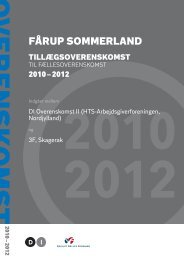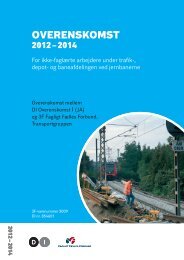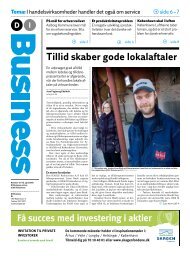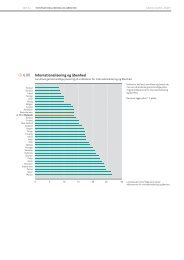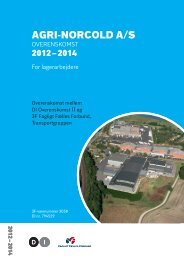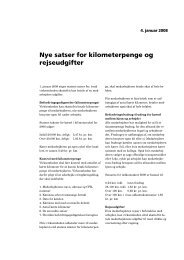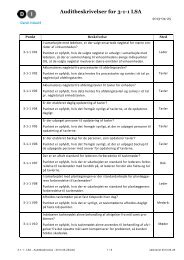Hydrogen and its competitors, 2004
Hydrogen and its competitors, 2004
Hydrogen and its competitors, 2004
You also want an ePaper? Increase the reach of your titles
YUMPU automatically turns print PDFs into web optimized ePapers that Google loves.
Risø Energy Report 3<strong>Hydrogen</strong> in the Danish energy system 214important hydrogen technologies [7]. Danish R&D inhydrogen production, for instance, ranges all the wayfrom processes based on fossil fuels, through biomass, tobasic research on hydrogen-producing enzymes, biomimetics<strong>and</strong> photo-catalysis.Of course, these different R&D areas are at very differentstages of development. <strong>Hydrogen</strong> production from fossilfuels is well established, <strong>and</strong> hydrogen from biomass isclose to commercial use. More direct methods, such ashydrogen from enzymes or photo-catalysis, still requiressubstantial fundamental research. Both the TechnicalUniversity of Denmark (DTU) <strong>and</strong> the Southern Universityof Denmark (SDU) have strong backgrounds in thesenew methods of producing hydrogen.Fuel cells probably take up even more of Denmark's R&Dresources than do hydrogen production technologies.Danish researchers have a good basic background in fuelcells, especially in the development of electrodes (bothanodes <strong>and</strong> cathodes). Both PEMFCs <strong>and</strong> SOFCs facesimilar issues when it comes to basic research on electrodes,<strong>and</strong> this work also applies to fuel cells run inreverse to produce hydrogen by electrolysis. Danishresearchers are also working hard to develop better electrolytes.Fuel cell technology has already entered the demonstrationphase, but new materials are needed before the technologycan become viable for mass production. Forexample, platinum <strong>and</strong> related metals have been used ascatalysts in demonstration PEMFCs, but the total worldproduction of platinum could only equip fuel cells for amaximum of 10-20 million cars a year. Platinum musttherefore be replaced by materials that are available ingreater quantities.Risø National Laboratory, DTU <strong>and</strong> the University ofAarhus are particularly strong in developing new electrodematerials. The same three institutions, plus theAalborg University <strong>and</strong> SDU, are active in optimising thedesign <strong>and</strong> manufacture of fuel cells <strong>and</strong> developing newmembranes.Danish researchers are also working on hydrogenstorage. Their emphasis is mainly on metal hydrides <strong>and</strong>hydrogen-carrying compounds, but they are also lookingat the problem of hydrogen embrittlement of materials.<strong>Hydrogen</strong> storage in metal hydrides is being studied inclosely related projects at the University of Aarhus, RisøNational Laboratory <strong>and</strong> DTU, <strong>and</strong> DTU is also investigatingalternative hydrogen carriers such as ammonia.Carbon-based hydrogen carriers such as methane <strong>and</strong>methanol are well known, but practical alternatives willrequire a good deal more research. We are not aware ofany Danish research in the important area of the environmentalimpact of hydrogen.The R&D barriers to affordable <strong>and</strong> efficient hydrogenuse are too large to be overcome by incrementalimprovements of existing technology. Instead, realbreakthroughs are needed – <strong>and</strong> these will require largeinvestments. Danish companies such as Haldor Topsøe,IRD Fuel Cells <strong>and</strong> Danfoss are certainly capable ofpicking up on any such breakthroughs.We should probably not expect hydrogen technology tobe implemented through st<strong>and</strong>ard market mechanisms.Fossil fuels are still too cheap for this to happen atpresent. We must hope that they remain cheap for aconsiderable time to come, given the current lack oftechnically <strong>and</strong> economically competitive hydrogen <strong>and</strong>fuel cell technologies.Instead, the driving forces for a hydrogen-based societyshould be found in the ability to reduce environmentalimpact <strong>and</strong> provide a safe <strong>and</strong> sustainable energy supply,on both short <strong>and</strong> long perspectives [4]. Focused technologypush, regulation <strong>and</strong> market incentives areneeded to bring these new technologies to market beforeour energy dem<strong>and</strong>s start to exceed our resources.There is, however, a growing niche market for hydrogen<strong>and</strong> fuel cells in applications such as portable powersupplies <strong>and</strong> backup systems, where cost <strong>and</strong> efficiencyare less important than weight <strong>and</strong> reliability. Suchapplications could help drive the technology forward tothe point where it is cheap enough for large-scale use <strong>and</strong>penetration into the energy sector.Another area that may be worth exploring is the production<strong>and</strong> consumption of hydrogen by fuel cellsconnected directly to wind turbines, since Denmarkalready has a unique market position in wind energy.ConclusionAs this chapter has shown, Denmark has a strong R&Dcommunity in hydrogen <strong>and</strong> fuel cells, whose work is ofhigh scientific quality <strong>and</strong> market relevance. Thecompetitiveness of Danish R&D is due to a continuedeffort by both research institutions <strong>and</strong> industry,supported by public funds. The emphasis is on SOFCs,but good work is also being done on basic research incatalysis, hydrogen storage, <strong>and</strong> demonstration of smallenergy conversion un<strong>its</strong>. A less concerted effort has beenmade in demonstration technology for stationary <strong>and</strong>transport applications, mainly financed through theshort-lived <strong>Hydrogen</strong> Research Programme.Over the years, Danish researchers have worked on anumber of European R&D projects, especially in fuelcells. Recently Danish partners have also been involvedin projects dealing with safety (HySafe) <strong>and</strong> distribution(Naturalhy).A big challenge is how to get the best results from R&Dinvestment in new energy technologies. Experienceshows that close collaboration across disciplinary <strong>and</strong>institutional boundaries is essential to progress in developingnew energy systems <strong>and</strong> to the competitiveness ofDanish industry. To work effectively with research teamsabroad <strong>and</strong> to be an attractive partner in large internationalprojects, Denmark needs a research communityon a national level. It is therefore important to have R&D



